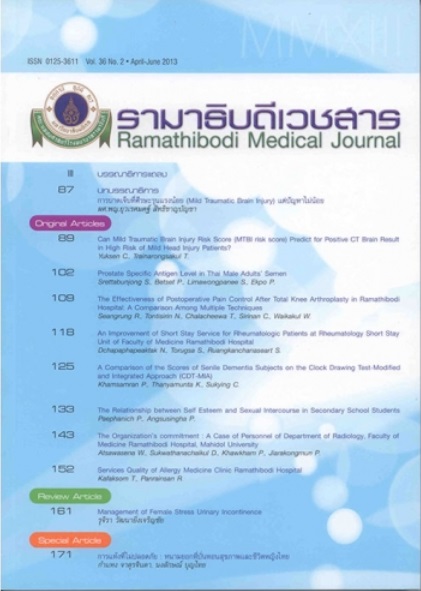A Comparison of the Scores of Senile Dementia Subjects on the Clock Drowing Test-Modified and Intergrated Approach (CDT-MIA)
Keywords:
Dementia, Alsheimer's disease, Vascular dementia, Elderly, Clock drawing testAbstract
Objective: The researcher compares the scores of selected senile dementia subjects and normal elderly subjects on the Clock Drawing Test-Modified and Integrated Approach (CDT-MIA). In addition, the researcher compares the scores of these senile dementia and normal elderly subjects on each section of the CDT-MIA by reference to demographical factors.
Metods: In this retrospective research, the researcher studied data from past records from members of a sample population consisiting of 374 elderly subjects. These elderly subjects had been diagnosed by physicians as having senile dementia, or had been judged normal on the basis of clock drawing tests.
Results: Half of the subjects as a consequence of Alzheimer's disease (50%), the scores on the CDT-MIA tests for thoes who were suffering from Alzheimer's disease and vascular disease and those who were judged normal differed in regard to numbers and hands scores and center. The subjects suffering from Alzheimer's disease who differed in the demographical characteristics of gender, educational level and occupation were found to exhibit parallel differences in regard to the aspects of numbers, hands, center and total scores. the subjects suffering from vascular disease who differed in the demographical factor of gender correspondingly differed in CDT-MIA scores in the aspect of hands. Furthermore, differences in the demographical factor of age corresponded to CDT-MIA score differences in the aspects of numbers, hands, center and total scores. Finally, differences in the demographical factor of educational level matched concomitant differences in CDT-MIA scores in the aspects of numbers, hands and total scores.
Conclusion: In addition, the researcher determined that the CDT-MIA score of those with Alzheimer's disease and vascular disease were lower than the normal range. However, the normal elderly subjects had scores that fell within the normal range.
References
Jitapunkul S. Health Behavior--in old age. Chulalongkorn University Press. Bangkok; 1999.
Sukying C. Alzheimer's disease. Ramathibodi Textbook of Psychiatry. 2005.
Aekplakorn W. Thai National Health Examination Survey 2008-2009. https://www.nheso.or.th/loagfile/child_NHESO4%20(1).pdf.
Jitapunkul S. Caring for a person with dementia. Chulalongkorn University Press. Bangkok; 2000.
Heinik J, Solomesh I, Bleich A, Berkman P. Are the clock-drawing test and the MMSE combined interchangeable with CAMCOG as a dementia evaluation instrument in a specialized outpatient setting?. J Geriatr Psychiatry Neurol. 2003;16(2):74-9.
Ananjanich P, Krairit O. Caregiving guide for dementia patients. The Dementia Association of Thailand. Bangkok; 2011.
Srisontisuk S. Rural Sociology: Theoretical concepts and social trends. Chulalongkorn University Press. Bangkok; 1996.
Ittasakul P. Comparison of different score of Clock Drawing Test-Modified and Integrated Approach in dementia patients of Alzheimer's disease and vascular disease. Bangkok; 2007.
Witoonpanich P, Rattanasiri S. Sukying C. CDT-MIA test with dementia patients of Alzheimer's disease and vascular disease. Bangkok; 2010.
Heinik J, Solomesh I, Lin R, et al. Clock Drawing Test-Modified and Integrated Approach (CDT-MIA): description and preliminary examination of its validity and reliability in dementia patients referred to a specialized psychogeriatric setting. J Geriatr Psychiatry Neurol. 2004;17(2):73-80.
Peter Braunberger. The Clock Drawing Test. https://www.neurosurvival.ca/ClinicalAssistant/scales/clock_drawing_test.htm.













